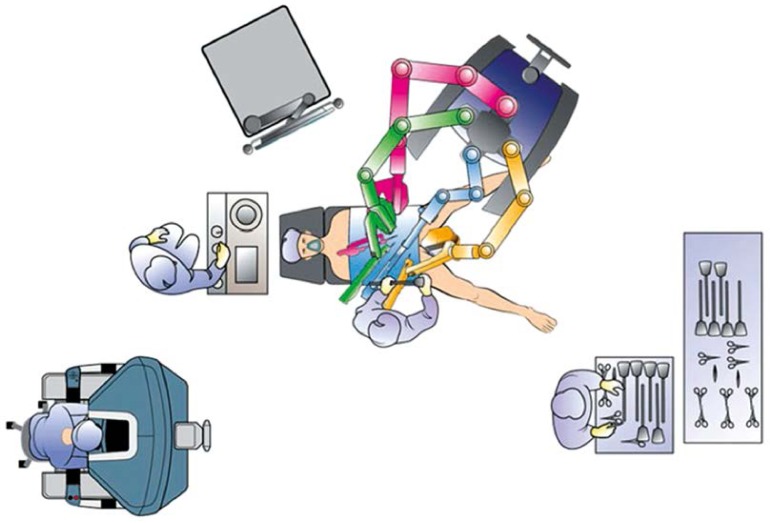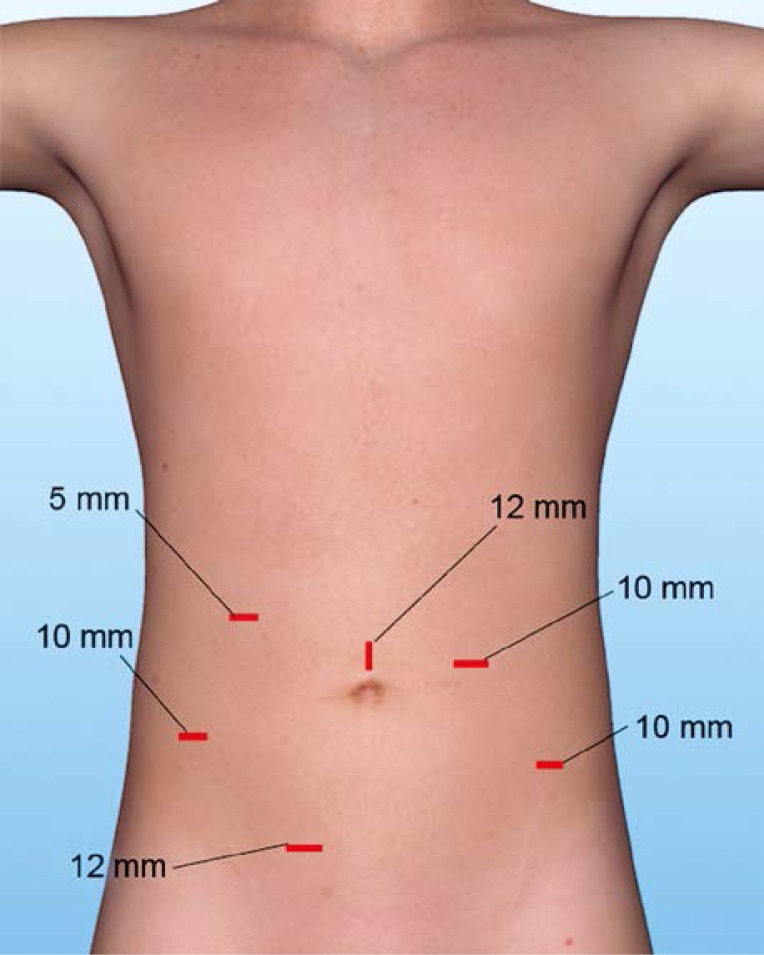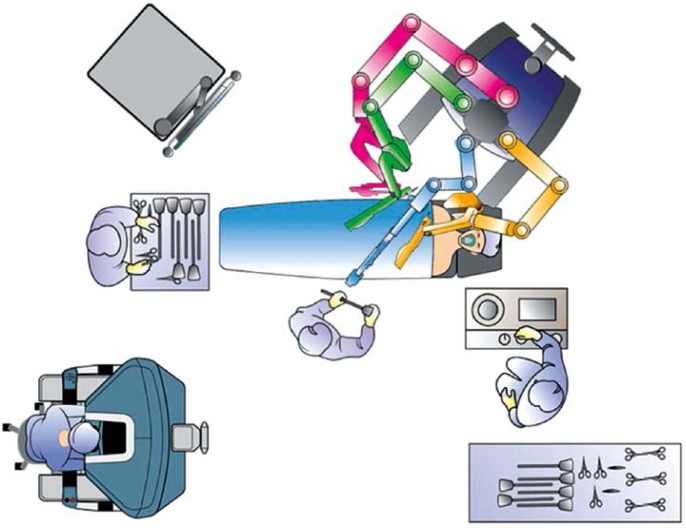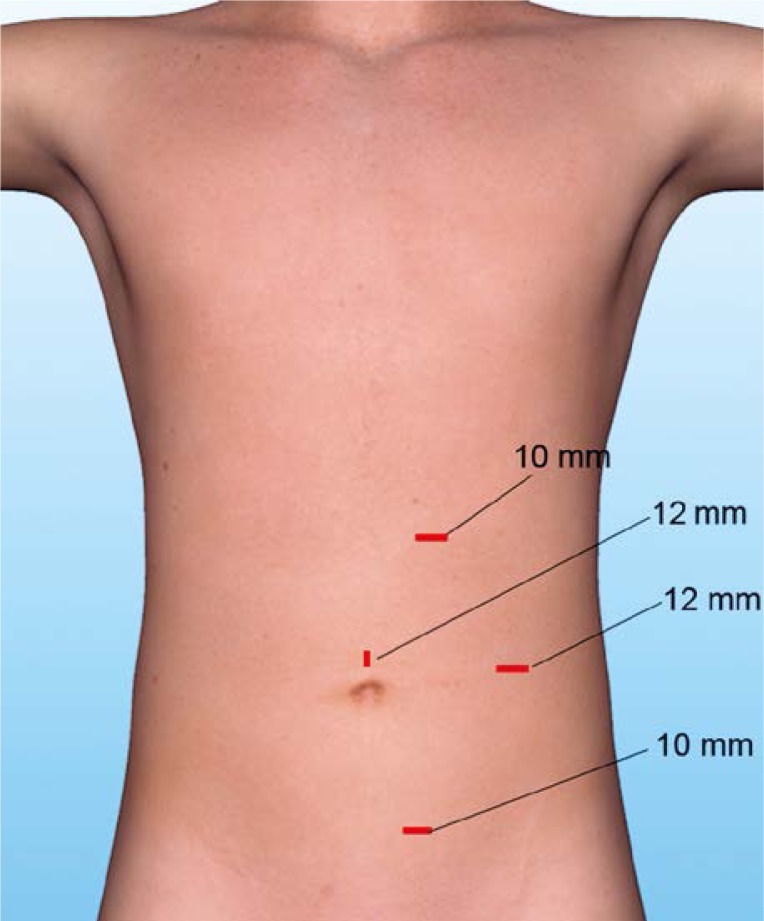Abstract
Introduction
Laparoscopy has been introduced into the field of colorectal surgery with the aim of reducing morbidity. One of the major barriers to overcome is the steep learning curve. Robotic surgery offers substantial advantages over traditional laparoscopy, which make the whole procedure more user friendly.
Aim
To present our initial experiences with robotic assisted colorectal surgery.
Material and methods
Thirty-five patients with colorectal cancer underwent robotic assisted procedures between 2011 and 2013.
Results
In total we performed 16 low anterior resections, 14 right colectomies, 3 abdominosacral resections and 2 left colectomies. There were 22 males and 13 females. The mean operative time was 315 ±65 min for a low anterior resection. The mean length of hospital stay was 6.4 ±1 days. There were 4 conversions to open procedures, 2 anastomotic leaks, and 1 colovaginal fistula. The mean lymph node yield was 12.7 ±4.3. The resection margin was negative in all but 1 patient.
Conclusions
We agree with the opinion that robotic surgery brings many advantages in pelvic dissections. In order to facilitate safe acquisition of robotic total mesorectal excision skills, surgeons should begin with female patients, and less advanced rectal cancer. In some instances robotic assistance can be helpful in right colectomies.
Keywords: robotic surgery, colorectal cancer, laparoscopy
Introduction
Colorectal resection is typically associated with significant morbidity and mortality. Complications can occur in up to one third of patients. The most frequent complications include wound infection, small bowel obstruction and cardiopulmonary problems [1].
Laparoscopy has been introduced into the field of colorectal surgery in the hope of reducing invasiveness and decreasing morbidity. Several trials have demonstrated that laparoscopic colorectal surgery (LCS) offers improved short-term outcomes in elective, benign and malignant colonic disease in comparison to open surgery [2–5]. The rising interest in minimally invasive surgery has resulted in an increase in the use of LCS in the US and Western Europe [6, 7]. In countries such as Poland LCS still remains unpopular. One of the major limiting factors is the steep learning curve that requires up to 150 procedures to reach an expert level of competence [8, 9].
The da Vinci robot is the latest operative modality in the arsenal of minimally invasive surgery. The advantages of the robot are widely discussed in the literature [10]. Unlike other minimally invasive methods the robotic system offers a camera with a three dimensional view of the operating field and 10× magnification. In addition the surgeon has control of three independently working arms, each equipped with an EndoWrist instrument that has seven degrees of freedom, 180° articulation and 540° rotation.
Aim
The aim of this article is to present our initial experiences with robotically assisted surgery in the field of colon and rectal surgery.
Material and methods
The da Vinci system was installed in our hospital (Wroclaw County Hospital, WSSK) in December of 2010. Prior to its installation our surgical staff underwent extensive training in robotics centres across the US and Europe.
The first robotic procedure at our institution, a left hemicolectomy, was performed in December 2010 by Professor Giuseppe Spinoglio. Between 2011 and 2013 our surgical team consisting of general surgeons, urologists and gynaecologists performed a total 156 robotic procedures. This number includes 35 robotic colorectal resections performed mostly by two surgeons with qualifications in robotic surgery. Patients were selected for a robotic approach based on the surgeon's discretion and the availability of the da Vinci system and trained staff. An attempt was made to offer a robotic procedure to every consenting patient with a rectal or right colon lesion (T1–T3), ASA class 1 to 3, and without any additional risk for prolonged anaesthesia. Financial limitations and time constrains often precluded a robotic approach.
Patient demographics, complications, and perioperative outcomes were recorded prospectively into our departmental database and analysed.
Surgical technique
Low anterior resection
The patient is placed on the operating table in the Trendelenburg position (Figure 1). For rectal resection the da Vinci system is situated between the patient's legs or on the left side of the patient. Typically we used 6 ports: a 12 mm camera trocar placed at the umbilicus, three 10 mm robotic ports located in the right and left lower quadrant and two laparoscopic ports (5 mm and 12 mm) for the surgical assistant (Figure 2). At our institution a low anterior resection for rectal cancer is routinely performed using a hybrid or totally robotic technique. The hybrid technique differs from the fully robotic method in the way the first phase of the surgery is conducted: control of the inferior mesenteric artery and vein, mobilisation of the left colon and optionally the splenic flexure is performed laparoscopically. The da Vinci system is used exclusively for total mesorectal excision [11]. In the totally robotic approach the robot is used to control both left colon and pelvic dissection. This approach might require the rearrangement of the robotic arms during the procedure [12]. The specimen is extracted from the abdominal cavity via a small Pfannenstiel incision.
Figure 1.
Position of the robot, rectal dissection
Figure 2.
Port placement, low anterior resection
Abdominoperineal resection
A totally robotic approach is also used in abdominoperineal resection (APR). The specimen is extracted through a perineal incision and thus a laparotomy can be avoided.
Right colectomy
For a right colectomy the da Vinci system is docked on the right side of the patient. The patient is placed on the operating table in a supine position with the right side up (Figure 3). In total 4 ports are used: a 12 mm camera port at the umbilicus, 2 robotic 10 mm ports are placed in the upper and lower left quadrants and a 5 mm laparoscopic assistant port is placed at the level and left of the umbilicus (Figure 4). The specimen is extracted via a small midline minilaparotomy. Anastomosis is routinely performed extracorporeally [13].
Figure 3.
Position of the robot, right hemicolectomy
Figure 4.
Port placement, right hemicolectomy
Results
From 2011 to 2013 we performed 35 robotic assisted colon and rectal resections. This number included 16 low anterior resections (LAR), 14 right colectomies (Rh), 3 abdominosacral resections (ASR), and 2 left colectomies (Lh). In 2 of the LAR cases a concomitant hysterectomy was performed. There were 22 males and 13 females in our series (Table I). The mean body mass index (BMI) was 29.4 ±4.9 kg/m2.
Table I.
Demographics and perioperative parameters
| Parameter | Result |
|---|---|
| Age, mean ± SD [years] | 65 ±12 |
| Male/female | 22/13 |
| BMI, mean ± SD [kg/m2] | 29.4 ±4.9 |
| T stage (rectal cancer): | |
| T4 | 2 |
| T3 | 10 |
| T2 | 5 |
| Tis | 2 |
| Mean operative time, mean ± SD [min]: | |
| Low anterior resection | 315 ±65 |
| Right colectomy | 168 ±49 |
| Mean blood loss, mean ± SD [ml]: | |
| Low anterior resection | 107 ±53 |
| Right colectomy | 45 ±10 |
| Conversion, n (%) | 4 (11.4) |
| Length of hospital stay (uncomplicated patients), mean ± SD [days] | 6.4 ±1 |
| Positive circumferential resection margin (rectal cancer), n (%) | 1 (5) |
| Lymph node harvest, mean ± SD | 12.7 ±4.3 |
Among the patients undergoing rectal dissection 9 (47%) underwent neoadjuvant therapy and 12 (63%) had an advanced T3/T4 lesion. Total operative time was calculated from the time of the first incision to skin closure. The average time was 168 ±49 min for a right colectomy and 315 ±65 min for low anterior resection. On average blood loss was estimated at 65 ±10 ml for Rh and 120 ±53 ml for LAR. There were 2 cases of intraoperative bowel laceration, which were identified instantly and secured with serosal stitches. We observed 4 conversions that occurred solely during the LAR procedure. In 3 cases the reason for the conversion was an inability to achieve adequate retraction in a narrow male pelvis. In the remaining case multiple adhesions excluded a minimally invasive approach. The mean length of hospital stay was 6.4 ±1 days, excluding patients with an anastomotic leak. Median number of harvested lymph nodes was 12.7 ±4.3. A positive circumferential resection margin was noted in one patient with an advanced rectal cancer after a short term of neoadjuvant treatment.
Major complications occurred in 3 patients and included 2 anastomotic leaks (12.5%) and 1 case of a colovaginal fistula. There were 2 reoperations within 30 days after the initial procedure. In both cases the reason for re-interventions was an anastomotic leak. The first patient was a 69-year-old woman with a T3N1 adenocarcinoma in the mid rectum. She underwent a long course of neoadjuvant treatment and a subsequent low anterior resection with a diverting ileostomy. On the fifth postoperative day she presented with clinical symptoms of anastomotic dehiscence and underwent a diagnostic laparoscopy and subsequently laparotomy with wash-up and drainage. The second patient was a 68-year-old man with a T3N0 rectal cancer located in the mid rectum after short course of radiotherapy. He presented with clinical symptoms of an anastomotic leak on the seventh postoperative day and required a laparotomy with a wash-up and a loop colostomy. Two more patients necessitated re-intervention within 1 year of the primary procedure. The first was a 49-year-old woman with a T3N1 rectal cancer after neoadjuvant therapy who underwent an uncomplicated robotic LAR with a concomitant hysterectomy (due to large uterine myomas). Two months later during her chemotherapy treatment she presented with symptoms of a colovaginal fistula for which she received a loop colostomy. The second patient was a 58-year-old man with a T4N2 lesion located in the caecum. He underwent a robotic right colectomy. Out of 15 lymph nodes harvested 6 showed signs of metastasis on the pathology report. Eleven months after the primary procedure he developed a recurrent disease in the regional lymph nodes, which required a laparotomy.
Discussion
The development of an automated surgical system has been the dream of medical pioneers since the advent of modern medicine. In the late twentieth century advances in technology and the idea of telesurgery have driven these ideas to fruition: the development of a surgical robot. Initially, the first robots were invented to perform certain tasks in hazardous environments such as battlefields or space missions.
The true advent in the clinical use of master-slave telemanipulators is related to introduction of the da Vinci robotic system. It was the first telerobotic system approved for intra-abdominal surgery in the USA by the Food and Drug Administration. Since then the popularity of robotic surgery has been steadily growing. In 2013 there were 2966 surgical robots working worldwide, with hysterectomies and prostatectomies being the most commonly performed robotic procedures [14].
The first robotic assisted colorectal resection was reported by Weber et al. in 2001 [15]. Amazingly, surgeons have been slow to take up robotic surgery, perhaps because they had had more than a decade of experience with laparoscopic surgery. At present, given the particular benefit of using robotics in pelvic procedures, there is great interest in the application of a surgical robot for a total mesorectal excision. Current evidence suggests that robotic rectal surgery might offer better short-term outcomes when applied in selected patients; however it is associated with increased cost and operating time. Obesity, male gender, neoadjuvant therapy and tumours located in the lower rectum are the best indications for robotic surgery. Proponents of the robotic technique claim that endowristed robotic instruments allow a surgeon to approach the rectum from different directions and angles, thus permitting precise retraction and sharp dissection [16–18]. The application of robotics in colon surgery is more debatable. Data available in the literature indicate that in comparison to standard laparoscopy the robotic approach produces similar outcomes, but takes longer and is associated with higher cost [19, 20].
In this article we present our early experiences with robotic colorectal surgery. In accordance with the data available, from the beginning we used the surgical robot for rectal dissection and less often for colon surgery. Although our team is still learning, we were able to confirm the safety and feasibility of the robotic approach. Despite a challenging group of patients, R0 resection was accomplished in all but one case. The average lymph node harvest of 12.7 lymph nodes further confirms the efficiency and oncologic safety of the robotic approach. We agree with an opinion presented in the medical literature that robotic surgery brings many advantages in pelvic dissections. The rationale behind this is the fact that a console operator can use three working arms with articulated instruments. This is an operating system that allows for total control over the operating field. The surgeon can use up to three instruments as well as a camera all at once. The role of a skilled assistant is still very important but is limited in comparison to a laparoscopic or open technique. In our experience from the beginning we tried to attempt difficult TME in male patients and advanced tumours. In fact we found this group of patients particularly difficult. Often it was very challenging to achieve good retraction and to create a proper plane of dissection deep in the pelvis. In our series this resulted in prolonged operative time and conversions. We can conclude that in order to facilitate safe and stepwise acquisition of robotic TME skills, surgeons should begin with female patients and ideally less advanced rectal cancer. After gaining adequate experience more challenging tumours should be attempted. The available data suggest that a range from 15 to 25 cases is required to achieve a higher level of competence. This correlates well with our observations and we suggest circa 20 rectal procedures prior to attempting robotic TME in more complex patients.
In some instances robotic assistance can be appreciated in right colectomies. At first we believed that a right colectomy was a good “training” procedure. Typically a right colectomy is a relatively straightforward operation with low complication rates that permits the entire robotic team to acquire experience and competence. With time we found robotic assistance to be very helpful during dissection of the ileocolic pedicle. The fine movements of the robotic instruments allow for a precise lymphadenectomy along ileocolic vessels. This is an early observation, which needs to be validated in future.
Prolonged operative time is often described as one of the major drawbacks of robotic surgery. We found that our mean operative time of 315 min for rectal resection is only just acceptable and we hope to reduce the operating room time with experience. On the other hand, evidence published in the literature shows that even in the hands of an expert robotic LAR takes up to 280 min [21].
The other frequently discussed shortcomings of robotic surgery are the limited range of movements of the robotic arms, the lack of tactile feedback and the bulkiness of the entire robotic system. In our opinion, these shortcomings are of some importance but the major limiting factor is the high cost of robotic technology. The da Vinci system costs approximately USD 1.75–2.2 million depending on the version. In addition, one should calculate the cost of robotic disposable instruments. Typically for a rectal or colon resection the additional expenses per procedure vary between USD 1000 and 1500. Obligatory yearly servicing expenses are calculated at approximately USD 200 000. Combining the high capital cost of the system, maintenance and the price of the disposable instruments, cost effectiveness of robotic surgery today is a major issue not only in Poland. One should understand that the current da Vinci system is very successful but only the first routinely used surgical robot. The technology continues to develop. We anticipate that progression in research will reduce the size, improve the functionality and lower the cost.
Conclusions
Robotic technology is undoubtedly an exciting development in the field of minimally invasive surgery. Although there is limited evidence from randomized clinical trials to support the use of robotics in colorectal surgery, we believe it is here to stay. We agree that robotic surgery brings many advantages in pelvic dissections. It permits average surgeons to adopt minimally invasive techniques and skilled surgeons to go beyond the boundaries of minimally invasive procedures. Nevertheless, in order to facilitate safe and stepwise acquisition of robotic TME skills, surgeons should begin with female patients and ideally less advanced rectal cancer. In some instances robotic assistance can be appreciated in right colectomies.
Acknowledgments
This publication is part of the project “Wrovasc – Integrated Cardiovascular Centre”, co-financed by the European Regional Development Fund, within Innovative Economy Operational Program, 2007–2013, implemented in the Regional Specialist Hospital, Research and Development Centre in Wroclaw.
References
- 1.Alves A, Panis Y, Mathieu P, et al. Association Française de Chirurgie Postoperative mortality and morbidity in French patients undergoing colorectal surgery: results of a prospective multicenter study. Arch Surg. 2005;140:278–83. doi: 10.1001/archsurg.140.3.278. [DOI] [PubMed] [Google Scholar]
- 2.Lacy AM, Garcia-Valdecasas JC, Delgado S, et al. Laparoscopy-assisted colectomy versus open colectomy for treatment of non-metastatic colon cancer: a randomised trial. Lancet. 2002;359:2224–9. doi: 10.1016/S0140-6736(02)09290-5. [DOI] [PubMed] [Google Scholar]
- 3.The Clinical Outcomes of Surgical Therapy Study Group. A comparison of laparoscopically assisted and open colectomy for colon cancer. N Engl J Med. 2004;350:2050–9. doi: 10.1056/NEJMoa032651. [DOI] [PubMed] [Google Scholar]
- 4.Guillou PJ, Quirke P, Thorpe H, et al. MRC CLASICC trial group Short-term endpoints of conventional versus laparoscopic-assisted surgery in patients with colorectal cancer (MRC CLASICC trial): multicentre, randomised controlled trial. Lancet. 2005;365:1718–26. doi: 10.1016/S0140-6736(05)66545-2. [DOI] [PubMed] [Google Scholar]
- 5.Wałęga P, Kenig J, Richter P. Transanal endoscopic microsurgery combined with endoscopic posterior mesorectum resection in the treatment of patients with T1 rectal cancer – 3-year results. Videosurgery Miniinv. 2014;9:40–5. doi: 10.5114/wiitm.2014.40384. [DOI] [PMC free article] [PubMed] [Google Scholar]
- 6.Simorov A, Shaligram A, Shostrom V, et al. Laparoscopic colon resection trends in utilization and rate of conversion to open procedure: a national database review of academic medical centers. Ann Surg. 2012;256:462–8. doi: 10.1097/SLA.0b013e3182657ec5. [DOI] [PubMed] [Google Scholar]
- 7.Kolfschoten NE, van Leersum NJ, Gooiker GA, et al. Successful and safe introduction of laparoscopic colorectal cancer surgery in Dutch hospitals. Ann Surg. 2013;257:916–21. doi: 10.1097/SLA.0b013e31825d0f37. [DOI] [PubMed] [Google Scholar]
- 8.Miskovic D, Ni M, Wyles SM, et al. Learning curve and case selection in laparoscopic colorectal surgery: systematic review and international multicenter analysis of 4852 cases. Dis Colon Rectum. 2012;55:1300–10. doi: 10.1097/DCR.0b013e31826ab4dd. [DOI] [PubMed] [Google Scholar]
- 9.Rabasová M, Martínek L. Conversion risk factors in laparoscopic colorectal surgery. Videosurgery Miniinv. 2012;7:240–5. doi: 10.5114/wiitm.2011.28906. [DOI] [PMC free article] [PubMed] [Google Scholar]
- 10.Witkiewicz W. A new quality and breakthrough or an expensive gadget? [Polish] J Oncol. 2013;63:423–9. [Google Scholar]
- 11.Zawadzki M, Velchuru VR, Albalawi SA, et al. Is hybrid robotic laparoscopic assistance the ideal approach for restorative rectal cancer dissection? Colorectal Dis. 2013;15:1026–32. doi: 10.1111/codi.12209. [DOI] [PubMed] [Google Scholar]
- 12.Hellan M, Stein H, Pigazzi A. Totally robotic low anterior resection with total mesorectal excision and splenic flexure mobilization. Surg Endosc. 2009;23:447–51. doi: 10.1007/s00464-008-0193-5. [DOI] [PubMed] [Google Scholar]
- 13.Witkiewicz W, Zawadzki M, Rząca M, et al. Robot-assisted right colectomy: surgical technique and review of the literature. Videosurgery Miniinv. 2013;8:253–7. doi: 10.5114/wiitm.2011.33761. [DOI] [PMC free article] [PubMed] [Google Scholar]
- 14. http://www.intuitivesurgical.com/
- 15.Weber P, Merola S, Wasielewski A, Ballantyne G. Telerobotic-assisted laparoscopic right and sigmoid colectomies for benign disease. Dis Colon Rectum. 2002;45:1689–96. doi: 10.1007/s10350-004-7261-2. [DOI] [PubMed] [Google Scholar]
- 16.Baik SH, Kwon HY, Kim SJ, et al. Robotic versus laparoscopic low anterior resection of rectal cancer: short-term outcome of a prospective comparative study. Ann Surg Oncol. 2009;16:1480–7. doi: 10.1245/s10434-009-0435-3. [DOI] [PubMed] [Google Scholar]
- 17.DeSouza AL, Prasad LM, Marecik SJ, et al. Total mesorectal excision for rectal cancer: the potential advantage of robotic assistance. Dis Colon Rectum. 2010;53:1611–7. doi: 10.1007/DCR.0b013e3181f22f1f. [DOI] [PubMed] [Google Scholar]
- 18.Yang Y, Wang F, Zhang P, et al. Robot-assisted versus conventional laparoscopic surgery for colorectal disease, focusing on rectal cancer: a meta-analysis. Ann Surg Oncol. 2012;19:3727–36. doi: 10.1245/s10434-012-2429-9. [DOI] [PubMed] [Google Scholar]
- 19.deSouza AL, Prasad LM, Park JJ, et al. Robotic assistance in right hemicolectomy: is there a role? Dis Colon Rectum. 2010;53:1000–6. doi: 10.1007/DCR.0b013e3181d32096. [DOI] [PubMed] [Google Scholar]
- 20.Park JS, Choi GS, Park SY, et al. Randomized clinical trial of robot-assisted versus standard laparoscopic right colectomy. Br J Surg. 2012;99:1219–26. doi: 10.1002/bjs.8841. [DOI] [PubMed] [Google Scholar]
- 21.Baek SJ, Kim SH, Cho JS, et al. Robotic versus conventional laparoscopic surgery for rectal cancer: a cost analysis from a single institute in Korea. World J Surg. 2012;36:2722–9. doi: 10.1007/s00268-012-1728-4. [DOI] [PubMed] [Google Scholar]






